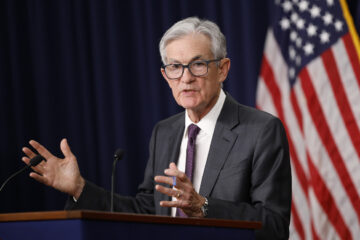“The Committee anticipates that ongoing increases in the target range will be appropriate in order to attain a stance of monetary policy that is sufficiently restrictive to return inflation to 2% over time,” the Fed said.v
Updated at 2:46 pm EST
The Federal Reserve raised its benchmark interest rate for the eighth consecutive policy meeting Wednesday, adding the “ongoing” increases remain appropriate going forward, as it continues to battle elevated inflation in the world’s biggest economy.
Fed Chairman Jerome Powell stressed that the “full effect” of rate hikes has yet to be felt, adding that rates would need to climb to a “restrictive level” and remain there for some time.
The Fed lifted its Fed Funds rate by 25 basis points to a range of 4.5% to 4.75%, the highest since 2008, and said ongoing be needed in order to bring inflation more closely, and more consistently, towards its 2% target. The decision was unanimous, the Federal Reserve said.
Stock Market Today: Stocks Lower As Fed Decision Looms; ISM, JOLTs Data Rattle Bulls
“The Committee anticipates that ongoing increases in the target range will be appropriate in order to attain a stance of monetary policy that is sufficiently restrictive to return inflation to 2% over time,” the Fed said in a statement released in parallel with the rate decision.
“In determining the extent of future increases in the target range, the Committee will take into account the cumulative tightening of monetary policy, the lags with which monetary policy affects economic activity and inflation, and economic and financial developments,” the statement added.
On Wall Street, U.S. stocks pared earlier declines, with the S&P 500 marked 20 points higher on the session while the Dow Jones Industrial Average fell 77 points. The tech-focused Nasdaq was marked 135 points higher
Benchmark 10-year Treasury note yields bumped 8 basis points lower to 3.437% while 2-year notes slipped 5 basis points to 4.17%.
The U.S. dollar index, meanwhile, was marked 0.30% lower at 101.78 in the wake of the Fed announcement and prior to Powell’s press conference in Washington.
Markets are pricing in an 86.3% chance that the Fed will hike rates by another 25 basis points in March, but the balance of bets for the Fed’s May meeting suggest rates holding at between 4.75% and 5% into the summer and beyond, with a small rate cut priced-in for the Fed’s November meeting.
Fed Chair Jerome Powell Goes Quiet As Bond Markets See Recession, Rate Cuts
Consumer prices are most certainly moving in the direction the Fed was hoping to see — thanks in part to the 425 basis points in rate hikes put in place last year — with core consumer prices running at an annualized rate of just 3.1% over the three months ending in December.
That compares to the 6% run-rate over the third quarter, and the 7.2% peak recorded over the three months ending in June. Headline CPI. meanwhile, has slowed for sixth consecutive months, easing to 6.5% in December, while the Fed’s preferred PCE inflation gauge retreated to 4.4%, the lowest in more than a year, as real personal spending extended its recent slump.
On the other side of the Fed’s dual mandate, however, things look a bit more complicated. Unemployment is still hovering at the lowest levels in decades, at 3.5%, and the number of new applications for jobless benefits fell to the lowest levels since May last week.
At the same time, the Bureau of Labor Statistics said its December Job Openings and Labor Turnover report, commonly known as JOTLS, showed a staggering 11.012 million unfilled positions in the economy, up from 10.44 million in November and well ahead of Street forecasts.


